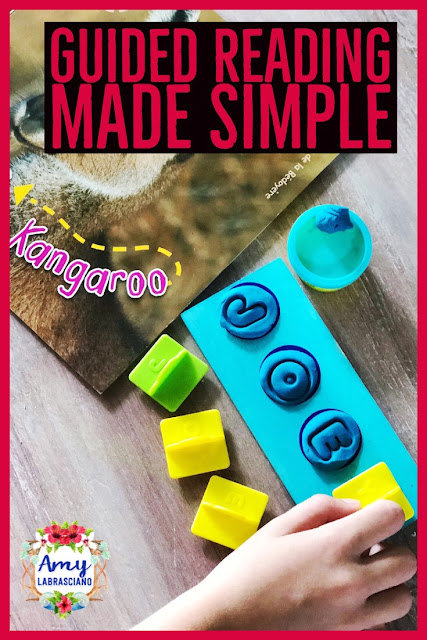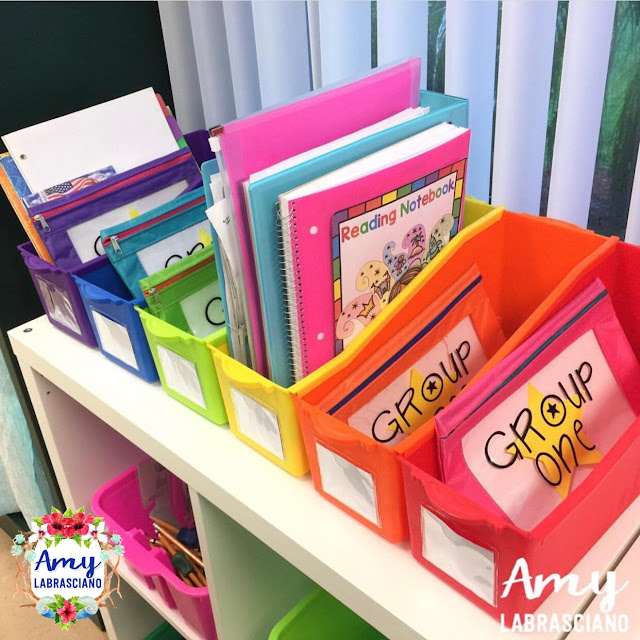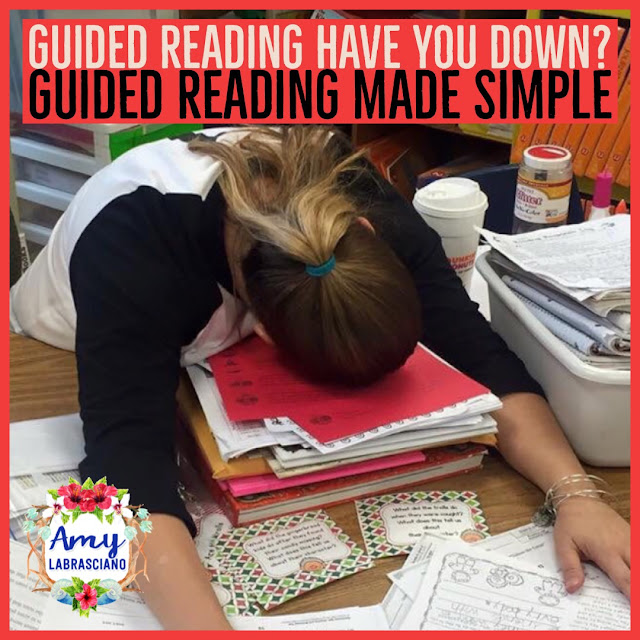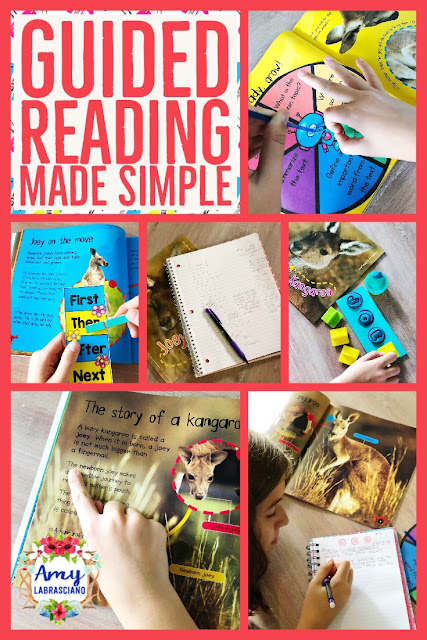One of the most challenging parts of the school day is easily guided reading. You have a limited amount of time and resources and a whole lot of individual needs to meet during a schedule that seems next to impossible to keep. Through a lot of careful research, training and first hand experience, I have come up with a simple to enact plan that works for my students and has shown years of proven results. Below I will detail those plans with the hope that it makes your day a little easier and a lot more productive through a realistic approach.
So what is guided reading anyway? Guided reading is the act in which a teacher pulls a small group together in order to guide them through the process of learning how to read. Students are grouped together with other students who have similar reading habits, skills and/or levels.
First Things First
To start the year off I set my students up for success in a way that could be a tiny bit controversial. I do not spend the first several weeks of school giving each student a DRA or reading assessment individually. Shocking I know because most people insist this is necessary. Instead I use the reading data the previous teacher gave and group the students accordingly. Now this doesn't mean this is where the students stay. Even if every reading assessment were 100% accurate students levels change during the summer, but our time is better spent in guided reading than it is doing yet another test. I would also like to add that I would never give these levels to parents until I've met with the students for at least 4 weeks and have a couple of running records to conclude their reading levels.
Next on the List
After I have them grouped I give them their guided reading books and do a quick running record on each student individually throughout the week while we meet in guided reading. Each group comes back consecutive days for 20 minutes until I've done a running record on all of them. As they come back I teach them my guided reading procedures. This includes: how they come back to the table quietly, start whisper reading right away, keep the book flat on the table so I can see where they are, they aren't allowed to keep pace with their friends, they start the book over when they are done or work on going through the book to understand pictures, diagrams and key details, they pick up their voice when I tap the table in front of them gently. It's important to note that most running records are taken on a warm read with the exception of this running record and one running record every quarter. A warm read means they have already read the text. Once a quarter I will take a cold reading running record which is the first time they have read a text. This routine is technical, but I'm very relaxed and make guided reading fun by choosing interesting books, having casual conversation, spending time giving each student individual attention and the student's favorite part, they get to choose a mini eraser from a jar every time they come back to the table. They remember this for years and love coming back to get one.

Time to get Started!
Once I have met with all of the students, (this never takes more than two weeks), I now have a good sense of who they are as a reader and their accurate level. The best part is that they have been coming back to guided reading for two weeks now and have engaged in meaningful reading instead of playing around in the classroom while I administer one on one tests for weeks on end. I make the necessary changes to the groups based on their running records. I explain to the students that groups will change throughout the year so they don't feel confused when they switch and then we get into a routine. My number one guiding thought on guided reading is that there is no magic pill for teaching reading. Just get the students back to the table and read with them as much as possible. Expose them to a wide array of genres, topics and vocabulary. IF YOU CAN'T DO ANYTHING ELSE, JUST GET THEM BACK TO YOUR TABLE AND READ WITH THEM! This is done in increments of 3 days a week. I try really hard to stick with four groups. You can meet with 3 groups a day for 20 minutes each and get through the week on four groups. Now sometimes this is impossible, but if your students are only a level to a couple of levels off from each other, it's better to make four groups than six groups that will never meet. We'll discuss what happens when you can't make four groups possible later on in this post. Schedule your groups to meet on consecutive days for your sanity and theirs. The following is an example: Group one will meet Monday-Wednesday. Group two will meet Tuesday-Thursday. Group three will meet Wednesday-Friday and Group four will meet Thursday - Monday. Try to schedule your second highest group to go Monday-Wednesday. It seems that a lot of holidays and events happen on Mondays and Fridays. If you schedule your higher groups then they will be less likely to struggle through the year when compared to peers. The same is true for your highest group which you should schedule as Group 4 Thursday - Monday. They will be the group less likely to be affected by the weekend and days off of school. This leaves groups 3 and 4 to go in the middle of the week when they are at their prime.


Follow The Plan
For all of your on level and above level students grades 2-3 follow this teaching plan:
Day One: Introduce Book and/or read the book with prompts, discussion and teaching. Sometimes you will have a chapter book so just leave out the introduce part if this isn't applicable.
Day Two: Finish the book or re-read. Discuss the book and continue teaching. Do a word work activity. Don't cut out word work for your higher kids, they really need it. My district did away with systematic phonics in 2nd grade and we paid the price. The students skills went down the drain and so did their test scores. If you are using a chapter book, just continue with reading. I'll also have my students meet with each other in their groups to read silently or discuss on days they aren't in guided reading. If you choose engaging fun books they love getting together on their own!
Day Three: Have students respond to the text in quick writing either in a notebook or on a whiteboard. For most of the year we stick to a notebook. During busy times we use a whiteboard so that I can cut down on grading. Discuss the writing with the group.
Whenever possible try to teach standards during guided reading that you are introducing in shared reading. It doesn't always work out, but when it does your students will feel more successful, the standard will be fresh in your mind as well as theirs and it just makes life easier to stick with the lesson plan and not come up with another one. Keep a list of all of your reading standards and make sure to check them off so that you know you have taught all of the standards to your students.
For Below Level Students:
Day One: Start with a skill lesson or word work. Then introduce a new story.
Day Two: Skill Lesson or word work. Read the story. Discuss and teach.
Day Three: Skill Lesson or word work. Respond to the text in guided writing.
For all of your on level students in grade 1:
Day One: Sight word review, Introduce a new book, Read the book, Discuss and Teach, Word work
Day Two: Sight word review, Reread the book with discussion, Teach, Sight word/Word Work,
Day Three: Word Work/Sight word review, Written response
If you absolutely have to meet with more than four groups, try meeting with one during bell work. If you can meet with your highest group in the morning during bellwork it frees up your guided reading block. If you can't do your highest group, is there anyone you can meet with then? If you absolutely can't meet during bellwork, try shortening your shared reading lesson to 15-20 minutes and squeezing in an extra group then. Students will benefit more from targeted guided reading then they will from shared reading.
So what are you teaching during guided reading?
What you will teach students depends on the needs of the majority of students in the group. You will have your overall lesson plan for the group, but it's ok to just teach one student one skill occasionally during their guided reading group while others read silently so that you can help that student grow. Make sure you are choosing diverse guided reading books that span genres and topics. It's also a good idea to just call back skill groups if needed. This is where you pull students with different reading levels who have the same need for a skill. One example might be that after you have taught silent e there's a group of kids still struggling with it even though they're in different groups. Another example might be comparing and contrasting. If you have students who need extra time, just pull them in a skill group in lieu of a guided reading group. The level of the text will match your lowest reader in the skill group or you'll need to differentiate to assist all of the students.

Word Work
Let's start with word work. Every group no matter how high they are will benefit from word work. Now a lot of reading experts will tell you to assess and determine what each student is lacking and then teach those skills during their group. If you do this you'll be jumping all over the place throughout the year and lose your mind. I'm going to be a bit controversial again. No one who works to their contractual hours has time to assess each students in a guided reading group in word work skills and teach word work skills tailored to everyone independently. Even if you stay late every night to get 4 extra word work lessons together, you'll burn yourself out and become an ineffective teacher.
Instead consider following a research based phonics calendar that will address all of the phonics skills your readers need to be successful in a systematic way that grows each reader the same as the aformentioned plan does and this time you will keep your sanity and stick to your contractual hours. Below you will find the calendar I use.
For below level students I stay on each skill longer until the group masters it. For above level groups I move through the beginning skills more quickly with larger words to work with.
For above level students we move into higher skills like contractions, homonyms, etc.
My calendar came from research I came across a while back. I wish I had the source to share with you, but it's long been lost. You can "google" researched based phonics calendar for (your grade) and a ton will pop up for you to look at. We start with short vowels, go into digraphs, then long vowels (double vowel teams, silent e) and we finish with blends. In first grade I used to switch long vowels with digraphs on the calendar. Some reading programs don't teach blends because if students know their consonant sounds they should be able to sound out blends hypothetically. In a real life classroom this isn't always the case so most effective teachers teach blends. We move quickly with above level and slower with below level. Realistically, if you hit all of the skills in a somewhat logical order, it really doesn't matter if you move a couple of lessons around.
One example of differentiating short vowels for word work:
2nd grade
below level
kit
on level
kite
kitten
above level
kitchen
Everyone is on the same calendar, but working on their level.
If they can read it, focus on spelling it. Kids need to be able to spell these words too!
To make life simple for you buy a teachers edition phonics book that has word lists by level. I have used Phonics A-Z for years. I keep it at my table and I can just give the students words from their list while they work with them on white boards, use play dough or other manipulatives. If you need inexpensive word work ideas
click here once you are done with this post. You can buy the used edition of most books on Amazon for under $5. This is how I get most of my books. Just click under the buy option for the used option. I have had all three editions of this book and I don't remember much changing from the 2nd to 3rd edition so get whatever the cheapest is for you.
Running Record Analysis
During guided reading you will take at least one running record during the warm reading. While you are taking the running records you will check to see if students:
solve words independently, self-monitor, are fluent, understand vocabulary, retells with 3 sentences for the beginning, middle and end and comprehends the big idea of the story. Don't get overwhelmed here. Just start with the first one, solves words, if they can't do it then teach them how. If they can move to self-monitor and so forth.
Word Solving
If students aren't solving new words, you will need to teach the group how to solve new words. Most transitional readers grades 2-3 will know how to do this. There are a ton of good resources to check out for this if needed. You can check out word attack strategies, word posters like (Flippy the Dolphin, Eagle Eye etc.). Your goal is to teach the student how to solve words without your prompting.
Self - Monitor
During reading if your students aren't monitoring their comprehension or word solving skills by self correcting, you will need to teach them how to do this. Start with smaller sections of the text/words and have your students retell that section or read the word. Have students use pictures to support their learning. Make sure they understand the big idea of that section. Once they master a small section give them larger sections and move on to a beginning, middle and end prompt. They can clip each section on a graphic organizer as they retell the story showing understanding. Have them work on their skills until they grow into flourishing readers.
Fluency
If students aren't reading in larger phrases and with intonation choose a fluency lesson. Most fluency lessons are done on one level below so that students aren't focused on word solving. Reader's theatre text is great for intonation. Timed reading is great for fluency speed. You can do phrase timing or sight word timing depending on the level of your group.
Once you have mastered the basics of guided reading, I encourage you to continue learning how to do more detailed lessons and miscue analysis on your students. As teachers we are ever evolving and growing as learners ourselves. Just remember to take it one day at a time, master smaller achievements before you move on and don't ever be hard on yourself! Teaching is hard enough without you being your own worst critic. (and please, GET THEM BACK TO YOUR READING TABLE TO READ FREQUENTLY!). Once you have a routine and feel comfortable about expanding your pedagogy consider checking out the professional book "The Next Step Forward In Guided Reading". This book spans grades k-8 and I have found it to be very useful. It's too new to have a used section on Amazon, but it was well worth the price.
Happy reading everyone!
Click below to find an easy to prep guided reading bundle for the entire year!























